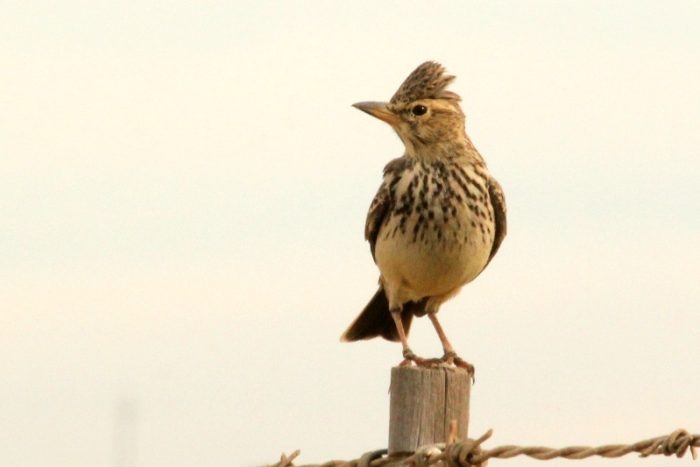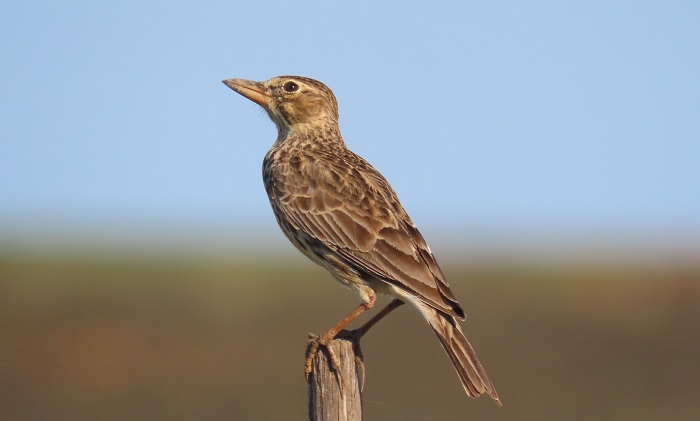Cover image by Kevin Lavery – Near Phillipstown, Northern Cape – BirdPix No. 228942 Large-billed Lark
Identification
The Large-billed Lark is a large, stocky lark with a heavy, yellow-based bill (diagnostic). The upperparts are buff brown with heavy, dark mottling. The facial markings are bold with a broad, buff-coloured supercilium. The malar stripe is bold and dark and there are dark lines passing through and under the eye. The undersides range from whitish to buff-brown and the breast is heavily marked with dark blotches. The overall appearance often has a yellowish hue. The wedge-shaped crest is usually held flat, but may be raised in alarm or when the bird is singing.

Photo by Karis Daniel
The sexes are alike, although the male is larger than the female. Juveniles have whitish feather tips on the crown, wings and back and fainter breast markings.
It is easily confused with the ‘thick-billed’ race of the Sabota Lark Mirafra sabota, which also inhabits karoo veld. The Sabota Lark has an overall whiter colouration, is less heavily marked on the breast and lacks the crest of the Large-billed Lark.
Status and Distribution
The Large-billed Lark is a locally common resident and is virtually endemic to South Africa and Lesotho. It also occurs in the extreme south of Namibia along the Orange River. It is widespread in the western parts of South Africa, occurring throughout the Western Cape, much of the Northern Cape (mostly south of the Orange River), and the drier western parts of the Eastern Cape. Its range extends through the western and southern Free State and across Lesotho.

Photo by Les Underhill
This lark is not considered threatened and has probably increased in abundance as a result of agriculture in the Western Cape. There is no evidence that there have been changes in the remainder of its distribution.

Details for map interpretation can be found here.
Habitat

Carnarvon district, Northern Cape
Photo by Ryan Tippett
The Large-billed Lark is most abundant in the succulent Karoo, followed by the Nama Karoo and the Grassy Karoo. It is also common in Alpine Grasslands on the Lesotho Highlands and in dry coastal Fynbos and agricultural fields of the Western Cape.

Near Witsand, Western Cape
Photo by Johan and Estelle van Rooyen
Behaviour
The Large-billed Lark is found either solitarily or in pairs. It has a distinctive call and is conspicuous when calling, usually from atop a fence, rock, termite mound or bush. Forages while walking about on flexed legs and collects food primarily off the ground. Feeds on various invertebrates, seeds and bulbs which it digs up with its bill. Drinks water regularly.

Photo by Jon Blanco
Breeding takes place during Spring and Summer and peaks from September through November. Males display at the start of the breeding season. In display the male rises 15 to 50m above the ground. He then circles in a fluttering, dipping arc while singing.
The nest is a cup made from grass and other fine plant fibres. It is built on a foundation of small sticks and placed at the base of a grass tussock or bush. 2 or 3 eggs are laid per clutch and are incubated by both sexes. The incubation period last around 16 days. The chicks are fed by both parents, however, the nestling and fledging periods have not been recorded.

Photo by Sybrand Venter
Further Resources
Species text adapted from the first Southern African Bird Atlas Project (SABAP1), 1997.
The use of photographs by Alan Collett, J Terblanche, John Cox, Phillip Nieuwoudt, Johan and Estelle van Rooyen and Zenobia van Dyk is acknowledged.
Virtual Museum (BirdPix > Search VM > By Scientific or Common Name).
Other common names: Thick-billed Lark (Alternative English Name); Dikbeklewerik (Afrikaans); Cochevis à gros bec (French); Dickschnabellerche (German); Cotovia-de-bico-grosso (Portuguese); Grootsnavelleeuwerik (Dutch).
A list of bird species in this format is available here.
Recommended citation format: Tippett RM 2023. Large-billed Lark (Galerida magnirostris). Biodiversity and Development Institute. Available online at http://thebdi.org/2023/02/20/large-billed-lark-galerida-magnirostris/

Photo by Les Underhill

